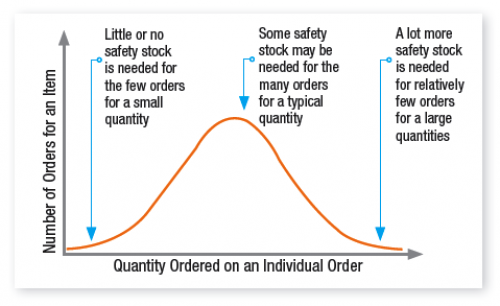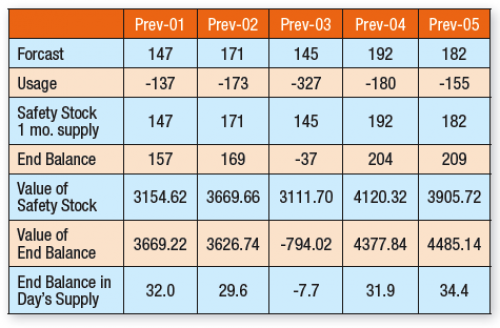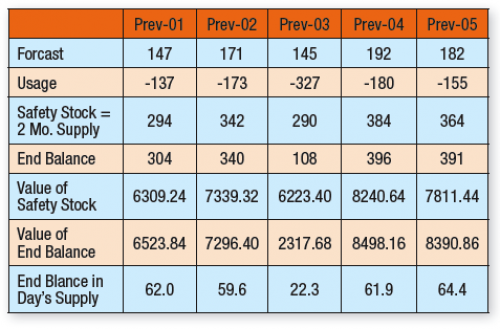STAFDA Inventory Consultant: Calculating safety stock
How to determine the stock levels you need to stay afloat.
 |
 |
Computer systems maintain the stock of inventory items with parameters such as minimum and maximum quantities. Some of these parameters are objective. That is, there is one right or optimum answer. For example, an economic order quantity balances the actual cost of a product, inventory carrying costs and costs of purchasing to determine the specific replenishment quantity that results in the lowest total cost of each piece of the product.
Other inventory parameters are subjective in nature. There is no one best answer. Safety stock (also known as safety allowance) is one of these. Safety stock provides protection against stock outs due to unexpected demand for a product or delays in receiving a replenishment shipment from a supplier. It is insurance. Like many other types of insurance, there is no “right” or optimum amount. If you talk to three different life insurance agents they will probably suggest you buy three different amounts of insurance. When you are
determining safety stock quantities you have to ask
yourself, “how much do we want to invest in preventing stockouts of this product?”
The answer will probably be different for various products you stock. In determining the safety stock amount for a particular product you have to ask:
- What is the likelihood that this product will experience a stockout?
- How disappointed will customers be if this product is not stock?
Products are more likely to be out of stock if they experience:
- Inconsistent supplier lead times — If vendor shipments are often several weeks late, you may want to keep some extra stock to “cover” customer demand during these unexpected delays in receiving a replenishment shipment.
- Large fluctuations in sales or usage — You might sell 10 pieces or 1,000 pieces of a product in a month without much advance notice of when usage will significantly increase.
Despite what your salespeople may tell you, customers probably don’t expect every item to be in stock 100 percent of the time. Even if you think they have these high expectations, you probably can’t afford to maintain enough safety stock of every item to meet every customer request 100 percent of the time. The reason why can be illustrated if we graph out the orders received for an item with recurring usage:

For any item we typically will receive a few orders for a relatively small quantity. Safety stock is usually not needed to fill these requests. You might need some safety stock to fill the many orders you receive for a typical quantity of the product. However, you would need a lot more safety stock to fill the relatively few orders you receive for an unusually large quantity out of stock inventory.
Because you do not ship unusually large quantities each month, unusually large amounts of safety stock would normally sit in your warehouse and gather dust. It would not be sold and provide a return on your investment.
But there are some products that should nearly always be available in whatever quantity customers request and therefore should have extraordinarily high safety stock quantities. These are what my original mentor Alan “Buddy” Silver referred to as “painful backorder” products. These are items that everyone assumes are always available, like milk at a supermarket. When you are told they are out of stock you often get a pain in your stomach.
Though it is evident that some items need more safety stock than others, most distributors maintain safety stock quantities with some general rules that apply to all stocked products. Typical safety stock policies include:
- We will maintain safety stock equal to 50% of lead time usage
- We will keep a one month supply on hand as safety stock
The result is that some products have too much safety stock (unnecessarily tying up funds, suppressing turnover and taking up too much warehouse space) while other items have too little safety stock (resulting in additional stockouts and disappointed customers).
Rather than applying safety stock across your entire inventory with a paint roller, we would like you to take a fine tipped artists brush and “dap” specific amounts of safety stock exactly where it is needed.
To assist you in fine tuning your insurance inventory, we have developed a simple way to measure the effectiveness of the safety stock quantities maintained for each item. To perform this analysis you will need the following information for each of your stocked products:
- Actual usage for each of the previous several months. We are using five months in this example from one of our customer’s inventory records.
- The demand forecast (i.e., predicted usage) for each of these months
- Your method for maintaining safety stock. In this example we are expressing safety stock as a number of month’s supply.
- The replacement cost per piece for each product. In this example the unit cost of the item is $21.46
For each month we subtract actual usage from the forecast:

In the Prev-02 and Prev-03 months, usage exceeds the forecast and as a result the ending balance is negative. Safety stock is required to prevent stockouts. Would one month’s safety stock be adequate to avoid both out of stock situations?

One month’s safety stock will prevent a stockout in month Prev-02 (note the positive ending balance of 169) but not in month Prev-03. What if we were to maintain two months usage as safety stock?

Two month’s safety stock will prevent stockouts during this period, but at what cost? The average investment in two month’s safety stock would be $7,184.81 [($6309.24 + $7339.32 + $6223.40 + $8240.64 + $7811.44) ÷ 5] while the average investment in one month’s safety stock would be half this amount.
In deciding how much safety stock you want to maintain, perform this analysis for all of the items in your inventory. See how many total potential stock outs you will experience with the various levels of safety stock.
Also note when all of the resulting ending balances for an item equal a high days supply. These products probably have fairly predictable usage and consistent lead times. You can probably reduce the safety stock for these items and still maintain your desired level of customer service.
The customer who supplied the data for our example has 1,738 items in inventory. One month’s safety stock every item would cost $3,071,143 and result in a total of 1,157 stockouts out of 8,690 opportunities (1,738 products * 5 months = 8,690). This results in an out of stock percentage of 13.3 percent (1,157 stockouts ÷ 8,690 opportunities = 13.3 percent) or an in stock percentage of 86.7 percent.
Two month’s safety stock for each item would cost $6,142,286 and result in 557 stockouts (out of stock percentage of 6.4 percent (557 stockouts ÷ 8690 opportunities = 6.4) percent or an in stock percentage of 93.6 percent.
With this information the customer began to fine tune their investment in inventory. They examined the stockouts of painful backorder items and selectively increased the safety stock until there were no out of stock situations. They implemented a corporate policy that these “core” products would always be available and never be out of stock. For some of these products the safety stock quantity represented a one month supply, for others a 1.5 month supply and for some up to a 2.6 month supply.
For a second group of “moderately important” products the customer examined several safety stock investments and corresponding projected in stock percentages, and decided to maintain a 93 percent in stock percentage. Buyers set the safety stock quantities so that projected stockouts only occurred in 7 percent of the months. Again they examined the projected ending balances from the analysis to best allocate the funds available for safety stock.
For a third group comprised of “less important” products, the customer compared various investments and resulting stockouts and decided on an 80 percent in stock percentage.
Your investment in safety stock is subjective. There is no “right’ answer. But with some simple tools and analysis, you can make an informed decision that will ensure the funds you make available for safety stock are invested as wisely as possible. CS
Jon Schreibfeder is president of Effective Inventory Management, Inc. He has authored numerous articles and several books on inventory management best practices and is the designated inventory management consultant for STAFDA. Jon can be reached at 972-304-3325 or by e-mail at info@effectiveinventory.com
















